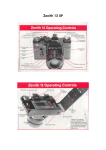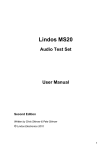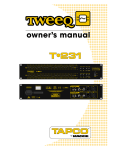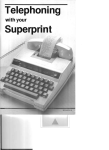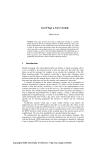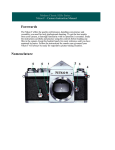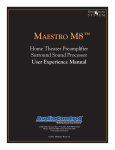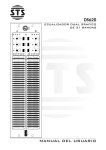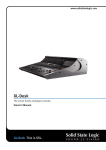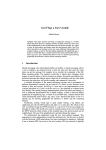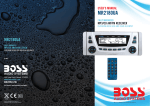Download Operation Manual
Transcript
SA-3051 and SA-3052 Spectrum Analyzer One-Third-Octave Real Time Analyzer With Memories and Digital SPL Display Operation Manual 22410 70th Avenue West • Mountlake Terrace, WA 98043 • Phone 425-775-8461 Fax 425-778-3166 P/N 9130430 www.audiocontrol.com © 1997 All Rights Reserved SA-3051/SA-3052 Operation Manual Table of Contents About This Manual............................................................... i Notational Conventions........................................................ i Notes, Cautions, and Warnings............................................. i Chapter 1 Introduction Test Instruments vs. Toys.................................................. 1-1 ANSI Filter Design........................................................... 1-2 Applications...................................................................... 1-3 Accessory Information...................................................... 1-3 Chapter 2 SA-3051/SA-3052 Front and Rear Panel Features Front Panel........................................................................ 2-1 Rear Panel......................................................................... 2-4 Chapter 3 Operation Quick-Start Information.................................................... 3-1 Using The SA-3051/SA-3052's Functions........................ 3-1 Storing a Response Curve................................................. 3-1 Recalling a Response Curve............................................. 3-1 Averaging Several Readings............................................. 3-2 Peak-Hold......................................................................... 3-2 Peak-Hold Digital SPL...................................................... 3-2 Exercising Your Options................................................... 3-2 Printer Operation............................................................... 3-2 Printers Supported............................................................. 3-2 Connector Pin Designations.............................................. 3-4 Battery Operation.............................................................. 3-4 A and C Weighted Measurements..................................... 3-5 Getting extreme at 175dB SPL......................................... 3-6 Chapter 4 Acoustical Testing with the SA-3051/SA-3052 Overview........................................................................... 4-1 Basic Procedure................................................................ 4-2 Body Effects...................................................................... 4-3 Sound Pressure Level and Hearing Loss.......................... 4-3 Chapter 5 SA-3051/SA-3052 Applications Sound System Equalization.............................................. 5-1 Hi-Fi Equalization............................................................. 5-1 Multi-Channel/THX Equalization.................................... 5-2 Sound System Equalization.............................................. 5-4 Monitor Speaker Equalization.......................................... 5-4 Fold Back Monitor Equalization....................................... 5-5 Feedback tuning................................................................ 5-5 Pink noise equalization and feedback tuning.................... 5-5 Component Checkout........................................................ 5-6 Tape Machine Alignment.................................................. 5-8 Sound and Music Monitoring........................................... 5-8 Crossover Testing.............................................................. 5-9 Chapter 6 Theory of Operation Input Circuitry ................................................................. 6-1 One-Third Octave Filters.................................................. 6-1 Signal Multiplexing and Analog to Digital Conversion... 6-1 Microprocessor Circuitry.................................................. 6-2 LED Display..................................................................... 6-2 Pink Noise Generator........................................................ 6-2 Chapter 7 Warranty Legalese ........................................................................... 7-1 Service Information.......................................................... 7-2 Chapter 8 Specifications SA-3051/SA-3052 Operation Manual About this Manual About This Manual This manual describes the AudioControl Industrial SA-3051/SA-3052 and a few of its audio applications. The manual is divided into several major sections. Section 1. Introduction is an introduction to the SA-3051/SA-3052 and to this manual. Section 2. SA-3051/SA-3052 Front and Rear Panel Features describes the physical features found on the front and rear panels of the SA-3051/SA-3052. Section 3. Operation describes how to use the various functions of the SA-3051/SA-3052 Section 4. Acoustical Testing with the SA-3051/SA-3052 has procedures for using the SA-3051/SA-3052 for sound system equalization and analysis. Section 5. SA-3051/SA-3052 Applications describes a few other applications for the SA-3051/SA-3052 besides equalizing sound systems. Section 6. Theory of Operation, for terminally curious technoids only, is a description of what goes on inside the confines of the box. Section 7. Warranty Information describes the SA-3051/SA-3052 warranty and tells how to obtain service for the SA-3051/SA-3052. We trust that you'll never need to use this section. Section 8. Specifications lists the SA-3051/SA-3052's specifications. Notational Conventions Within this manual, several different notation conventions are used to indicate various facets of the SA-3051/SA-3052's features. Small Caps Indicate a marked feature on the unit, like the control or the connector. They are also used within procedures to identify controls and switches by function. Italics and boldface Are used for emphasis. Words printed in boldface convey more emphasis than those printed in italics. Notes, Cautions, and Warnings Some of the text in this manual is set apart by the headings: Note, Caution, or Warning. These terms are used to denote varying degrees of awareness required by the user during installation, operation, or maintenance of the SA-3051/SA-3052. NOTE conveys information that may be helpful to the user. A note is similar to an aside during a conversation. CAUTION indicates a potential danger to the instrument. WARNING indicates a potential hazard to the operator. © 1997 AudioControl. All rights reserved. i SA-3051/SA-3052 Operation Manual Introduction Congratulations on purchasing one of the world's most popular audio analyzers. The AudioControl Industrial SA-3051/SA-3052 is an affordable, measurement-grade, one-third octave real-time analyzer designed for audio signal analysis. Previous analyzer designs were either too costly for the average professional or too inaccurate for serious use. The SA-3051/SA-3052 overcomes these inadequacies by combining a state-of-the-art microprocessor-based design with modern electronic manufacturing techniques. The result is a very accurate, quick and easy to use instrument, self contained in one box. The SA-3051/SA-3052 includes the following features: • 30 one-third octave bandwidth filters • Fourth-order filters conform to ANSI S1.11-1986 standards • Laboratory-grade calibrated measurement microphone • Internal digital pink noise source • 32 dB display window • 9 x 30 large-format LED display matrix • Full-screen digital SPL readout with 1/10th dB resolution • Six non-volatile memories with lithium battery backup • Frequency response averaging for up to six stored response curves • 20 second temporal averaging • Peak-hold • Balanced XLR microphone, balanced TRS ¼" phone jack and unbalanced RCA connector inputs • 175dB sound pressure level measurement (optional) • A- and C-weighting filter (optional) • Portable battery operation (SA-3052) • Parallel printer port (SA-3052) Test Instruments vs. Toys There is a fundamental difference between the many real-time analyzers currently available on the market today. That difference is one of calibration. An instrument that is calibrated is capable of making measurements based on some absolute reference (absolute measurement). An instrument that isn't calibrated can only make comparisons against a relative reference (relative measurement). For example, someone asks you, "How hot is it today?" If you step outside for a moment and reply, "Oh, a bit hotter than yesterday," that's a relative measurement. On the other hand, if you step outside and consult a certified laboratory thermometer and say "85 degrees F," you've made a measurement against an absolute reference. The SA-3051/SA-3052 was calibrated at the factory to meet or exceed its published specifications. You can make a measurement with the SA-3051/SA-3052 and compare it with a measurement made by any other measurement-grade instrument and know that you are comparing apples with apples. 1-1 SA-3051/SA-3052 Operation Manual ANSI Filter Design A real-time analyzer works by dividing the audio spectrum up into equal bandwidth parts using a set of calibrated (usually) bandpass filters. Then the output of each filter is displayed on some sort of level indicator: LED matrix, Video display, LCD, etc. The American National Standards Institute (ANSI) oversees the establishment and maintenance of various engineering standards in conjunction with the International Standards Organization (ISO) in Europe. These two standards organizations have established standards for the performance of the bandpass filters used for acoustical measurement purposes. For one-third octave analyzers, there are two classes of filters allowed by ANSI. These are Class II, and Class III. Class I is reserved for octave bandwidth analyzers. Class III filters are the hardest to design and manufacture and are usually only found on the most expensive (read unaffordable) analyzers. Class II filters, are easier (not easy, just easier) to design and manufacture than Class III filters. Any real-time analyzer intended for serious measurement work will use filters that at least meet Class II standards. The filters used in the SA-3051/SA-3052 analyzer meet or exceed the standards specified by ANSI for a Class II, Type E filter set. Figures 1.1 and 1.2 show two different one-third octave filters. Figure 1.1 is representative of those found in most lower-cost analyzers. Figure 1.2 is an actual filter used in the SA-3051/SA-3052. Note the difference in the response away from the center frequency. The inferior filter's broad response characteristic translates to potential measurement errors at frequencies removed from the band-center and undesirable interaction between adjacent frequency bands. Figure 1.1. A non-measurement quality one-third octave filter Figure 1.2. A measurement quality one-third octave filter 1-2 Introduction Applications The SA-3051/SA-3052 is well-suited to many audio applications including but not limited to: • Acoustical analysis for sound reinforcement or recording studios • Movie theater system setup and projector alignment • Fast frequency response measurements on amplifiers, tape recorders, equalizers, etc. • Tape recorder setup • Industrial noise measurement Accessory Information Model Description RM-10 Heavy steel 19-inch rack mount adapter. Requires 3 rack spaces (5.25 inches) BP-10 Rechargeable internal battery system (SA-3052) PI-10 PC compatible, parallel printer output port (SA-3052) CP-10 Adds owner’s name to PI-10 printout SPL-175 175 dB SPL measurement upgrade AC-10 Plug-in A- and C-weighting filter SC-10 Soft carrying case. Includes space for analyzer, mike and cables (SA-3052) Note: The SPL-175, BP-10, PI-10, and CP-10 options must be installed by the factory. BP-10 Rechargeable Internal Battery Pack The rechargeable battery option allows the SA-3052 to be used independent of AC mains power. The batteries install within the instrument and provide up to 4 hours of operation on a full charge. The batteries are recharged by plugging the instrument into a source of AC mains power and leaving the front panel Power switch set to Off for a period of 9 to 10 hours. PI-10 Printer Output The printer output option provides a Centronics parallel interface for a PC compatible printer (not provided). The analyzer-to-printer cable is a standard PC-type parallel printer cable (also not provided). The printed output is a form with suitable blank spaces for recording the time and place of the measurement and other data, followed by the a printed representation of the real-time spectrum display on the analyzer. CP-10 Customized Printout SC-10 Soft Carrying Case AC-10 A- and C-weighting Filter The CP-10 option customizes the printer output form to include six lines of data for your business name, address, and other data. Since this data is only factory installed, it has the additional benefit of “branding” your analyzer in case someone wanders off with your prize analyzer. You must have the PI-10 printer option installed before you can add the CP-10. The soft carrying case protects the SA-3052 from the ravages of portable operation. It includes a large pocket to carry the mike and cables. There is also a hatch on the bottom of the case to allow access to the power cord connection. The AC-10 A/C weighting filter is a compact plug-in module designed to be inserted inline with the microphone. The AC-10 applies the standard A- or C-weighting function to the microphone signal. SPL-175 High SPL option The SPL-175 option allows sound pressure level measurements up to 175dB. The SPL-175 includes a high SPL microphone and software upgrades. 1-3 SA-3051/SA-3052 Operation Manual Features SA-3051/SA-3052 Front and Rear Panel Features Figure 2.1. SA-3051/SA-3052 Front Panel with digital SPL readout Front Panel LED Display The left portion of the display shows the one-third octave energy content of the input signal from 25 Hz to 20kHz. Each column within the display represents one one-third octave band. The band centers are marked on the bottom of the screen. The right-hand end of the display indicates the setting of the dB switch, and consequently the amount of change in the input signal that each led on the left- hand side of the display represents. The far right portion of the display indicates the sound pressure level (SPL), relative to the settings of the dB switch and control. Power Switch Depressing the Power switch to the right turns the SA-3051/SA-3052 on. Pressing it to the left turns it off. Low Batt/Power LED The Low Batt/Power indicator illuminates solid green during normal operation of the SA-3052. When operating the SA-3052 on the optional internal rechargeable batteries, a flashing green LED indicates that the batteries need recharging. Once the Low Batt LED has begun flashing, there is approximately ½ hour of battery life remaining. The SA-3052 has a sense circuit that prevents operation of the instrument below critical battery cell voltage. This prevents total battery discharge, which shortens the cell life. To continue operation, the SA-3052 may be operated from the AC power line. The batteries may be recharged by plugging the SA-3052 into a suitable source of AC power, with the front panel Power switch set to the Off position for a period of 9 to 10 hours. The power LED will glow red while the batteries are charging and flash occasionally when fully charged. The minimum recharge time from the voltage-cutout state is around 2 hours, which will then operate the instrument for around one hour. Completely recharging the batteries from a discharged state (instrument dead) requires 9 to 10 hours (2 times the discharge time). SPL Momentarily pressing the SPL push-button switch toggles the SPL bargraph at the right side of the display window on and off. Pressing and holding the SPL push-button activates the full-screen digital SPL display. Momentarily pressing the SPL switch again restores normal analyzer operation. The associated LED indicator indicates the status of the SPL switch. The SPL bargraph display scaling is always 4 dB/step, regardless of the setting of the dB switch. The SPL switch works regardless of the setting of the Recall/Rta switch. This means that you can switch the SPL bargraph on and off even with a stored display. 2-1 SA-3051/SA-3052 Operation Manual Display Speed The display speed push-button switch is located underneath the SPL switch and to the left of the Fast, Med and Slow LEDs. The lighted LEDs to the right of the switch indicate the response time of the display. Press the button to change the decay time of the display. The Fast setting is optimized for looking at transients, the Med setting is useful for program monitoring, and the Slow setting averages 20 samples over a ½ second period. This works well for measurements using pink noise. A fourth display speed is a 20 second time average. It is indicated by the Slow LED flashing. During the first 20 seconds as the average is accumulating, the Slow LED will flash 2 times per second. Once the accumulator is full, the flashing will slow down to 1 flash per second. Memory The SA-3051/SA-3052 can store up to six different frequency response curves (including the SPL display) in its internal non-volatile memory. These memories are stored at the highest resolution of the SA3051/SA-3052, so you can scale the display with the dB/Step switch during memory recall. Any combination of the memories can also be averaged. Look in the Operation section of this manual for further information. An internal back-up battery maintains the contents of the memory for periods of up to one year, even with the AC power supply disconnected. This feature allows the unit to “remember” a standard curve that may be recalled each time that the SA-3051/SA-3052 is used. Pink Noise The internal pink-noise generator is an accurate, digital, laboratory-grade test source. The pink noise output is accurate throughout the measurement range to within 0.25dB. The maximum output provided at the ¼" tip-sleeve phone jack is 1 volt into a 600 load (unbalanced, ring and sleeve grounded), or 150 mW into a 4 ohm load. The signal level at this connector is controlled by the knob to its immediate left. The pink noise generator has sufficient output to drive virtually any speaker or crossover directly. Per Step This switch sets the resolution of the spectrum analyzer portion of the display. The setting represents the value of each LED in the display. Thus, a setting of 1dB per step causes each LED in the display to represent a 1dB change. At this setting, the overall range of the display is 9dB. At the 4-dB-per-step setting, each LED in the display represents a change of 4dB, with a 36dB overall display range. dB When using the SA-3051/SA-3052 for sound system equalization, start with the 4 dB/step setting and progressively decrease the setting of the dB Per Step switch as the equalization process progresses. For program monitoring, the 4dB position works well because it displays the widest dynamic range. Memorized response curves are always stored at 1-dB-per-step-resolution, regardless of the setting of the front panel switch. You can select whatever resolution you wish for a stored display when it is displayed and know that it is accurate. The same holds true for displays dumped to the printer output. 2-2 Features Sensitivity The dB Input Sensitivity control and switch select the reference level of the curve shown in the display window. The control to the right of the input selector switch is a fine adjustment and alters the range selected by the switch over a range of ±10 dB. The normal setting for this control is the detented (clickstopped) center position. dB Input The reference level of the display is shown on the display window by the light gray horizontal line. The actual reference level of the reference line corresponds to the dB level setting of the dBm/SPL switch. For example, the dBm/SPL switch (coarse adjustment) is set to 90dB. The light gray line on the display window represents a sound pressure level of 90dB if the 10dB control (fine adjustment) is set at the center-detented position. Input 3 A ¼" tip-ring-sleeve phone jack is used for connecting to balanced and unbalanced sources. Connect unbalanced sources by using a tip-sleeve (2 conductor) plug inserted into this jack. This input has an impedance of 10 kohms and is suitable for signal levels from -56dBu to +36dBu. An input signal of 0dBu represents 100dB SPL. Input 2 This is a standard audio (RCA) connector with an input impedance of 1 Mohm in parallel with 30 pF. The particular combination of resistance and capacitance allows connecting a standard oscilloscope probe to this input. This input is suitable for signal levels from -56dBu to +36dBu. An input signal of 0dBu represents 100dBSPL. Input 1 This is a standard +12 volt, phantom-powered, balanced microphone input. The phantom power supply is intended for the AudioControl Industrial CM-10 or SPL-175 measurement microphones. Ordinary dynamic microphones may also be connected directly to this input providing that they have a balanced output. Unbalanced microphones may not be used. This input is suitable for acoustical levels at the microphone ranging from 44dB SPL to 136dB SPL. The SPL display is only accurate if the AudioControl Industrial CM-10 microphone is used, or if the external microphone matches the sensitivity of the CM-10 microphone. CAUTION: A microphone with an unbalanced output may be damaged if connected to this input. CAUTION: AudioControl Industrial assumes no responsibility for microphones damaged in this CAUTION: manner. Connect microphones with ¼" phone plug connectors to the Balanced Input 3 CAUTION: connector. 2-3 SA-3051/SA-3052 Operation Manual Rear Panel Figure 2.2. SA-3051/SA-3052 Rear Panel AC Mains power input receptacle An IEC 3-prong receptacle provides the connection for AC power input to the SA-3051/SA-3052. The SA-3051/SA-3052 is factory supplied to operate at one of the following AC power supply voltages. The supplied configuration is marked on the rear panel of the unit. Consult the AudioControl Industrial factory for power supply conversion information. n 120 VAC, 60 Hz n 220-240 VAC, 50/60 Hz Power Fuse The correct fuse is listed as part AC power markings. Printer Interface (SA-3052) This is a female 25-pin connector (DB-25F) used for connection to an external PC-type printer (not supplied). The connector is wired for a parallel interface printer. (This connector is present only on the AudioControl Industrial SA-3052 which is equipped with the printer interface option.) A description of the pin connections can be found on page 3-4. Print (SA-3052) This momentary-contact switch is used to print the contents of the display onto an external printer. This switch is present only on the SA-3052 which is equipped with the printer interface option. Note For longest battery life, always leave the SA-3052 plugged into the AC supply when not in use. There is no danger of overcharging the battery pack. 2-4 Operation Operation Using the SA-3051/SA-3052 is simple and straightforward. This section describes the basic procedures. Quick-Start Information 1. Connect the SA-3051/SA-3052 to a suitable source of AC power. If your instrument is equipped with the battery option, the batteries must be charged before use. The correct AC power configuration is marked on the rear panel of the instrument. 2. Connect the input signal source to the appropriate input on the front panel of the instrument. 3. If you are using the internal pink noise source, connect the Pink Noise output of the analyzer to the amplifier or sound system line input. The Pink Noise output has sufficient power capacity to directly drive a loudspeaker to modest levels. 4. Set the dB Input switch so that signal peaks reach the upper third of the display. Adjust the dB Input control as needed. If the variable ±10 dB control is centered, then the gray line dividing the display represents the SPL setting of the dB switch. 5. Select the display resolution using the dB Per Step switch. The switch setting represents the value of each LED in the display. A scale is printed on the right-hand side of the display window. 6. Select the decay time of the display by pressing the push-button switch adjacent to the Fast, Med, or Slow LEDs. The Fast setting is suitable for viewing transients. The Med setting is suited to signal monitoring and the Slow setting works well for pink noise measurements. 7. You can determine the sound pressure level at the microphone by pressing and holding the SPL pushbutton for one second until the display changes to the digital mode. This will display the sound pressure level in 1/10th dB resolution. The SPL bargraph is always 4dB per step, regardless of the setting of the dB Per Step switch. Using The SA-3051/SA-3052's Functions Storing a Response Curve 1. Press the Store/Freeze button. The display is now frozen and ready to be stored. 2. Pressing the Memory button again steps through the six memories in sequence. The display shows the contents of each memory as it is selected. 3. The Recall and Rta LEDs are not illuminated. This indicates that the SA-3051/SA-3052 is ready to store the display. 4. Pressing the Store/Freeze button again stores the contents of the display into the selected memory. The associated LED indicators display which memory is currently active. 5. The yellow Recall LED illuminates to indicate that you are now in recall mode. You can recall any other memory for comparison purposes by selecting that memory by repeatedly pressing the Memory button. 6. Press the Recall/Rta button to return to real-time mode. Recalling a Response Curve 1. Press the Recall/Rta button until the Recall LED is illuminated. 2. Press the Memory push-button to successively view the contents of the six memories. 3. Pressing the Recall/Rta button again returns the SA-3051/SA-3052 to the RTA mode. 3-1 SA-3051/SA-3052 Operation Manual Averaging Several Readings The averaging mode allows up to 256 previously stored readings to be averaged together. The averaged result is stored in memory number six, replacing its contents. 1. Acquire and store up to six response curves. 2. Press and hold the Store/Freeze button for one second. The yellow Memory 6 LED is now flashing, indicating the initiation of the averaging mode. 3. Select the first memory for averaging using the Memory button. Touch the Store/Freeze button once. 4. Select the next memory for averaging using the Memory button. Touch the Store/Freeze button once. Repeat this step for each additional memory to be averaged. You can weight a specific memory by selecting it more than once. 5. After selecting the memory locations to be averaged, press and hold the Store/Freeze button for one second. The Memory 6 LED will come on solid and the average will be displayed on the screen and written into memory location 6. 6. The contents of memory location 6 are lost when the average is calculated. The result of the averaging operation is overwritten into memory location 6. Peak-Hold The Peak-Hold mode allows you to accumulate the highest peak level in any of the SA-3051/SA-3052's thirty display bands. This display may be stored in any memory location, averaged, etc. 1. Press and hold the Rta/Recall button for one second. The red RTA LED is now flashing, indicating the peak-hold mode is active. The display now holds the overall peak level for each of the thirty bands. 2. Pressing the Rta/Recall button again exits the peak-hold mode. Peak-Hold Digital SPL The digital SPL display may also be operated in peak-hold mode. 1. Press and hold the SPL button until the instrument enters digital SPL mode. 2. Press and hold the Recall/Rta button until the SPL LED starts flashing. 3. The SA-3051/SA-3052 is now in digital SPL peak-hold mode. Clearing the Internal Memories 1. Press and hold the Store/Freeze button while turning on the SA-3051/SA-3052. Exercising Your Options The following section describes the use of the SA-3052's additional features. Printer Operation Printer interface allows making hard-copy printouts of the SA-3052's display. The printer output is a form with space provided for logging the time and date of the job, as well as any other data. A sample is shown in figure 3.1. Printers Supported The SA-3052 printer interface is designed to connect to any Centronics-type parallel interface compatible printer (dot matrix, ink jet, laser, etc.). No special printer control codes or emulations are required. 3-2 Operation Note The parallel PC printer interface standard does not require any baud rate, parity or stop bit settings. You should not have to make any special settings in your printer to use the SA-3052. CAUTION: Do not connect the SA-3052 to a serial interface printer (Apple, Point of Sale, etc.). It will not print, and damage may be done to the analyzer and/or printer. AUDIOCONTROL INDUSTRIAL SYSTEM ANALYSIS By: Printing the display is easy. 1. Connect a parallel printer to the Printer Port on the rear of the SA-3052. 2. Recall the response curve memory that you wish to print...or... freeze the display. 3. Make sure that the printer is loaded with paper, connected to a power source, turned on, and on-line. Client _ _ _ _ _ _ _ _ _ _ _ _ _ _ _ _ _ Date _ _ _ _ _ _ _ _ Address _ _ _ _ _ _ _ _ _ _ _ _ _ _ _ _ _ Telephone City ZipCode _ _ _ _ _ _ _ _ _ _ _ State _ _ _ _ _ _ _ _ _ _ _ _ _ _ _ Job _ _ _ _ _ _ _ _ _ _ _ _ _ _ _ _ _ _ _ _ _ _ _ _ _ _ _ _ _ _ System Components: 4. Press the rear-panel Print button. Comments _ _ _ _ _ _ _ _ _ _ _ _ _ _ _ _ _ _ _ _ _ _ _ _ _ _ _ _ _ _ _ _ _ _ _ _ _ _ _ _ _ _ _ _ _ _ _ _ _ _ _ _ _ _ _ _ _ _ Technician _ _ _ _ _ _ _ _ _ _ _ _ _ _ _ _ _ _ _ _ _ _ _ _ _ _ AUDIOCONTROL SA-3052 SPECTRUM ANALYSIS System Frequency Response--One Third Octave dB * * * * * * * * * * * * ** * * * * * * * * * * * * * * * * 25 50 Bass 100 200 400 800 1.6k 3.15k Midrange SA-3052 V.2.24 (C) 1977 6.3k +12 +9 +6 +3 0 -3 -6 -9 -12 92 89 86 83 80 77 74 71 68 12.5k 20k Treble AudioControl (425) 775-8461 Figure 3.1. Printout Example. Note An abbreviated printout showing only the RTA curve may also be printed by double-clicking (pressing twice quickly) the Print button. 3-3 SA-3051/SA-3052 Operation Manual Connector Pin Designations The printer interface connector uses a DB25F connector. The connector wiring is the same as that used by PC-type computers so you can use any standard PC printer cable to connect the SA-3052 to your printer. The connector pin designations are shown in Figure 3.2. Figure 3.2. Parallel Interface Signals and Pin Assignments. Battery Operation A standard battery package allows the SA-3052 to be operated without connection to the AC mains supply. The battery supply has sufficient capacity to operate the SA-3052 continuously for 3 to 4 hours. The battery package uses a sealed gel-cel, lead-acid battery pack. An integral battery charger operates when the SA-3052 is plugged into the AC mains supply. The instrument must be turned off to charge the battery. Charging the Internal Battery Pack 1. Plug the SA-3052 into a suitable source of AC power. 2. Set the front panel Power switch to Off. 3. Leave the SA-3052 for a period of 8 to 10 hours (twice the discharge time). 4. The battery charger automatically adjusts the rate of charge as the battery reaches full charge. The Power/Charge LED will glow red then flash slowly when a full charge is reached. Once this occurs, the battery charger switches to trickle-charge mode to maintain the battery at full charge. Operating the SA-3052 on AC power will eventually discharge the battery. Getting the Most From Your Battery Pack. The SA-3052 uses a sealed, lead-acid storage battery. These batteries are not of the Nickel-Cadmium type commonly used for rechargeable applications. Lead-acid batteries offer some significant advantages over NiCad batteries. • Given proper charging and discharge depth, the batteries should deliver 1000 to 2000 charge/dis- charge cycles (4-5 years of normal operation). • Lead-Acid cells do not have memory effects from partial discharging or charging. • Higher energy density. The lead-acid design delivers more energy per unit volume than NiCad battery systems. • Lead-acid batteries can be charged in less time than NiCads. • Wider temperature range: -65 degrees Celsius to +65 degrees Celsius. 3-4 Operation Getting maximum performance from your battery pack is simple. Follow these simple suggestions: • Lead-acid batteries do not operate well when deeply discharged. Operate the SA- 3052 until the green low-battery indicator begins flashing. When the indicator begins flashing, you have approxi- mately 30 minutes of operation left. Cease operation and recharge the battery or switch over to AC power. • A low-voltage cutout prevents operation of the SA-3052 once the battery voltage reaches this point. The low-voltage cutout could make the instrument appear to be totally dead. If the SA-3052 appears dead, plug the instrument into a source of AC power. Ensure that the power switch is set to the OFF position. Leave the instrument plugged in for at least two hours and look for the red battery charg- ing LED to glow continously. If this "revives" the instrument, simply continue charging the batteries for another six to eight hours. If not, consult the factory for additional information. NOTE: The low-voltage cutout could make the instrument appear to be totally dead. If the SA-3051/SA-3052 appears dead, plug it into a source of AC power. Ensure that the analyzer is turned off. Leave it plugged in for at least two hours to charge. If the Charge LED by the power switch does not light, then you may not have AC power and the battery cells are not charging. If this “revives” the SA-3051/SA-3052, you can resume normal operation using AC mains power. Be sure to charge the batteries for another six to eight hours before using the portable battery mode. Plugging the SA-3051/SA-3052 into AC mains while using the battery power may cause the microprocessor to “hang”. If this occurs, turn the power off, then back on again. CAUTION: Always store the SA-3052 with the batteries fully charged. Leaving the analyzer stored with a partial charge for extended periods (more than two weeks) can damage the battery cells irreparably. The battery charging circuitry cannot overcharge the cells, so it is best to always leave the analyzer plugged into AC power for charging whenever it is not in use. A and C Weighted Measurements The AC-10 in-line weighting filter provides A- or C- weighting to the microphone input of the SA-3051/ SA-3052. Without the AC-10, the SA-3051/SA-3052’s measurements are unweighted. The AC-10 uses active filters to create the two weighting curves. Power for the filter is supplied by the phantom power supply on the microphone input of the SA-3051/SA-3052. Figure 3.3 A and C weighting filter response curves 3-5 SA-3051/SA-3052 Operation Manual To install the AC-10: 1. Unplug the CM-10 microphone from the mike cable. 2. Plug the AC-10 onto the end of the mike cable. 3. Plug the CM-10 into the AC-10. 4. Select the appropriate weighting curve with the A/C slide switch on the AC-10. figure 3.4 AC-10 weighting filter Getting extreme at 175dB SPL Warning: Exposure to sound pressure levels in excess of 90 decibels causes hearing damage. AudioControl Industrial assumes no liability or responsibility for hearing loss incurred directly or indirectly by the use of the SA-3051/SA-3052. Please remember to practice safe sound. Figure 3.5 CM-10 microphone SPL-175 microphone The standard SA-3051/SA-3052 measures sound pressure levels up to 136dB. The SPL-175 option includes a high SPL microphone to allow measurements from 100 to SPL-175. The high SPL mode only works in the digital SPL display mode. Don’t use the SPL-175 microphone for RTA measurements. Selecting the SPL operating mode is very simple. 1. Press and hold the SPL button to enter the digital SPL mode. 2. The display will alternate HI and LO. Release the SPL button when the appropriate mode is displayed. 3. When the digital SPL mode is in the HI range, a single LED will stay lit at the left edge of the display. Hi Range Indicator Figure 3.6 SA-3051/SA-3052 display showing HI SPL mode 3-6 Input Sensitivity Scale Conversion Lo Range 70dB 80dB 90dB 100dB 110dB 120dB Hi Range 110dB 120dB 130dB 140dB 150dB 160dB Figure 3.7 HI SPL conversion scale Overview Acoustical Testing with the SA-3051/SA-3052 Perhaps the most important use of the SA-3051/SA-3052 is as an acoustical measuring tool: e.g. equalizing sound systems. This section of the manual discusses the process and rationale behind using a realtime-analyzer and an equalizer as an integral part of any sound system. Overview (or what we're trying to accomplish) The primary reason for using the analyzer with an equalizer is to do what our ears can't do reliably: adjust a sound system to a known reference condition. The reason that we can't do this "by ear" is our rather poor long term auditory memory. In other words, our hearing process is very adaptive. Our hearing adjusts to compensate for varying conditions, sound pressure levels, and tonal balances. When presented with a change, our sense of hearing can discern that change very readily. This is our short-term auditory memory. On the other hand, our ears are not very good at remembering things over a long period of time, especially when there are unrelated sounds between the periods of recall. Another problem is threshold shift caused by exposure to loud sounds. Without getting into a lot of detail (don't worry, we will later), the threshold of hearing (the SPL where you can sense the presence of a sound) shifts upward when the ear is exposed to loud sound. The recovery time can be measured in hours to days, depending on the intensity and duration of the exposure. For this discussion, it’s just another problem, or source of error. For these reasons, and many more, a real-time-analyzer with a calibrated microphone is one of the most popular methods of measuring the frequency response of a sound system within an acoustical space. In a nutshell, a pink noise source excites the space, a microphone picks up the acoustical signal and converts it to an electrical signal. The real-time-analyzer (RTA) breaks the signal up into equal octave-percentage bands, and displays the signal level of each band individually. The display can be LCD, a video display, or an LED matrix. The SA-3051/SA-3052 uses the latter method. In the real world, very few things are perfect, and expensive sound systems are no exception. Traditionally loudspeakers are measured in an anechoic (adj: an - not having, echoic - echoes) chamber. An anechoic chamber is a large room, with the floor, walls, and ceiling lined with acoustically absorbent material. Any sound emitted within the chamber is absorbed. Being inside an anechoic chamber is a strange experience. First, you are standing on a suspended floor made of steel cables. If you are afraid of heights, this is just a good beginning. Since the walls absorb all sound, it is eerily quiet inside. You can actually hear your blood coursing through your blood vessels. At any rate, an anechoic chamber is hardly the same as an average living room. However perfectly the loudspeaker measured within the chamber, putting it into an average living room changes the whole ball game. First, the floor, walls, and ceiling are anything but totally absorbent. This allows the room to have resonances, standing waves, and a sound of its own. The room interacts with our perfect loudspeaker to produce an imperfect system. Before we go any further, you should note that equalization is a tool. Correctly applied it can do wonders. Some situations are beyond help. No amount of equalization will overcome the problems caused by reflections, standing waves, and excessive resonance. There is only one cure for an acoustical disaster: explosives. There is more to equalizing a sound system than simply adjusting the equalizer until the analyzer display is a straight line. It's important to know which defects you can improve on, and which ones you're wasting your time on. If this weren't so, we could train monkeys to do this, and a fair number of system installers would be looking for work. 4-1 SA-3051/SA-3052 Operation Manual Basic Procedure Equalizing any sound system is basically a five-part process: 1. Listen 2. Measure 3. Balance speaker components and equalize 4. Listen 5. Trim equalization settings The following procedure describes the basics of equalizing a sound system installed in a real-world acoustical space. If the sound system is biamplified, or if the speakers have level controls (like midrange and/or tweeter level controls), the first thing that you should do is to set these controls for the best overall response curve. 1. Connect a pink noise source to the sound system. This could be the output of the SA-3051/SA-3052’s pink noise generator, or a tape or CD with prerecorded pink noise on it. 2. Place the microphone at the listening position. It helps to position the microphone away from any reflecting surfaces. Orient the microphone as shown in Figure 4.1. 3. Turn on the sound system. Increase the pink-noise level until the SPL is at least 10 dB over the ambient noise level. If the response curve looks terrible (huge peaks and/or valleys), try moving the microphone slightly. If the peaks or valleys go away, the problem was probably the microphone position. 4. Store the resulting response curve in one of the SA-3051/SA-3052’s memories. 5. Repeat this process (position mike, store response) several times. 6. Recall the stored curves and derive a curve that is an average of all of them. See page 3-2 for instructions on averaging. The rationale behind averaging is to help filter out response flaws that are caused by the microphone position versus those flaws that are caused by the acoustical environment and its interaction with the sound system. 7. Now adjust the equalizer to make the average response curve flat. (Level out the peaks, and smooth the overall curve). 8. Recheck your work by checking the response through the microphone positions that you used to derive the average curve. Repeat the equalization process if necessary. Your overall goal in this process is smooth response, not necessarily flat response. 9. Insert any high-frequency rolloff or bass boost needed for contouring or system voicing. Figure 4.1. Positioning the microphone Now that you have an idea of the basic procedure, here are a few hints: • If the response curve really looks horrible, experiment with the microphone position. You may have just picked out a position that happened to be at a room node, or inside of a standing wave. A few inches should tell you. • The first thing that you should attack with the equalizer is the highest peak showing on the display. When you've pulled this down to the level of the surrounding terrain, find the next highest peak and pull it down. Repeat this process as necessary. Adjust the output gain control of the equalizer to make up for the equalizer's loss. 4-2 Overview • If the peak straddles two equalizer controls, then split the difference between them. Unless the system and/or space is really poor, you won't need much equalization to smooth things out. • Don’t try to equalize out dips in the overall response curve, unless they are quite shallow (less than 3 dB). Anything more than this is a decided waste of power (3 dB = twice power). Fortunately for us, our hearing is more sensitive to presence rather than absence. Thus, we'll hear the peaks in the response long before we notice the absence caused by the dips. • Once you've gotten the overall curve flattened out, listen to the system with music and speech. You'll probably want to put in some controlled high-frequency rolloff...say 1 to 3 dB per octave starting somewhere between 1 and 8 kHz. • If you're equalizing an autosound system, you'll probably need to introduce some carefully contoured bass boost to overcome the low-frequency ambient noise level in the car, and to help compensate for the Fletcher-Munson effect. • If the system is installed in a car, drive around at varying speeds to assess the effect of engine and road noise on the performance of the sound system. You may need to trim the overall equalization to suit. • Listen to the system for an extended period of time, at varying volume levels. If the overall system equalization curve isn't right, listening fatigue will let you know that you haven't finished yet. It may take several tries to get it just right. Body Effects When measuring, it’s important to keep any reflecting surfaces away from the microphone. This includes your body if you are hand-holding the microphone. If you aren't careful, the reflection can cause response errors because of the multiple paths into the microphone. Ideally, the microphone should be suspended in free space. In reality three feet should be adequate spacing. In an automobile, the three foot rule may turn into science fiction. On the other hand, that's the environment that the system is going to be listened to in. In this case, the rule goes out the window. You may notice more variation in the response as you move nearer to the windows. That is just another good reason for using a multiplicity of measurement points, and taking an average of all of them. Sound Pressure Level and Hearing Loss Although it’s great to have a sound system that will achieve levels of 130+ dB SPL, it’s also great to be able to hear it for a while. It's a proven fact that one of the causes of hearing loss is prolonged exposure to excessive sound levels. Research has shown that prolonged exposure to average levels under 90 dB SPL will not cause harm to our hearing. As the level exceeds 90 dB SPL, the capacity for damage increases, and the damage becomes more and more permanent. The amount of exposure that our ears can withstand without damage is related to intensity and time. We can tolerate 105 dB SPL for less time than we can 95 dB SPL. This is because of the way our ears respond to stimulus outside of the normal range of sounds in our environment. For example, if you enter a building where there is loud music playing, it may seem loud to you at first, but after 20 minutes or so, the music will seem less loud. That is because your hearing has acclimated itself to the new ambient environment. Unless you're conscious of this, you may not notice the change until you leave the building and go outside. Suddenly everything seems very quiet. You have just experienced what is known as threshold shift. After a while, your threshold will return to a level that is close (but not quite) to your original threshold. This is one mechanism of permanent hearing loss. Warning: AudioControl Industrial assumes no liability or responsibility for hearing loss Warning incurred directly or indirectly by the use of the SA-3051/SA-3052. 4-3 SA-3051/SA-3052 Operation Manual SA-3051/SA-3052 Applications The SA-3051/SA-3052 has many applications. Some of these include: • Sound System Equalization • Monitor System Feedback Control • Movie Theater Setup • Home Theater Equalization and Setup • Tape Machine Alignment • Sound and Music Monitoring • Component Testing Sound System Equalization Sound reinforcement systems, large or small benefit even more from carefully applied equalization. While only dynamite can really cure a really bad case of poor acoustics, equalization comes right after loudspeaker array design when it comes to getting the most out of any speaker system in any room. If you set up in different venues night after night, the SA-3051/SA-3052 can be the impartial judge that helps you make your sound consistent, night after night. The SA-3051/SA-3052 can work wonders on a home stereo. Most home stereos can benefit from a bit of carefully applied equalization. Such equalization can go a long way towards enhancing your listening pleasure. The SA-3051/SA-3052 can also be used to verify the performance of various portions of the electronics in your system. Whether you're equalizing a home stereo, or a 100,000 watt concert sound system, the basic technique is the same: 1. Listen 2. Measure 3. Balance speaker components and equalize 4. Listen 5. Trim equalization settings Hi-Fi Equalization Before attempting any corrective equalization, use the SA-3051/SA-3052 to make a preliminary assessment of the situation. Use several microphone positions, finally drawing a curve that represents the average of a representative sample of the positions. We recommend no less than 3 different positions in a one to three foot cube around your listening position. Next, adjust the various level controls on the speakers themselves to smooth out the mid- and highfrequency response. You can combat peaky bass response by trying various elevations above the floor. Conversely, you can aid anemic bass response by using floor or corner placement. The name of the game here is to get things as "right" as possible without equalization. Now it’s time to use the equalizer. Remember what we discussed in Section 2. It's important to remember to not try to equalize the dips in the overall response curves unless they are quite shallow. Deeper dips may be due to a door, window, or other surface acting as a diaphragmatic absorber (the acoustical equivalent of a black hole). If that is the case, then structural modification of the offending surface is the only real cure. If you get really desperate, there’s always explosives. If you're using an octave-band equalizer, you've probably noticed that the analyzer has a few more bands than the equalizer does. With octave-band equalizers and octave-band analyzers, the important thing that is missing is the response characteristic in-between adjacent bands. The equalizer's controls interact with each other, allowing you to affect the response in the sidebands. If the EQ controls didn't interact, the 5-1 Applications equalizer wouldn't be very useful...let alone musical. The SA-3051/SA-3052 shows you what is going on in-between the bands of the equalizer and the effects of the controls away from their band-centers. Because of the interaction, you can still deal with problems that aren't conveniently centered on a particular control by splitting the difference between two adjacent controls. Regardless of which equalizer you're using, an overall guiding principle is: "Less is Better." With good components to start with, all that should be needed is gentle, gradual shaping. Avoid large amounts of boost or cut as well as sharp discontinuities in the overall curve. Once you're finished, you'll want to add a controlled amount of high-frequency rolloff. Why? Because "ruler-flat" speakers sound unnaturally bright to most ears. Ordinarily we hear most sounds at a distance. This causes high-frequency loss because of the friction between the sound wave and the air, as well as other losses due to absorption caused by walls and other surfaces. As a starting point, try 1 to 3 dB per octave, starting somewhere between 1 and 8 kHz. Experiment; let your ears be your guide and the SA-3051/SA-3052 be your compass. Setting Up Home Theaters There are three main areas of adjustment when optimizing a home theater sound system. They are: 1. Placement of speakers. 2. The acoustic environment of the room. 3. The system electronics. Work on items 1 and 2 before fine tuning with the electronics. Here are some tips to get the most out of your speaker placement and acoustic environment. Speaker Placement We (and every speaker manufacturer we’ve ever talked to) can’t over-emphasize the importance of proper speaker placement. Some speakers require very particular placement in relation to the back and side walls; all speakers demand careful placement in relation to your home theater’s characteristics. Start by consulting the speaker’s owner’s manual and don’t be afraid to experiment...a lot. Pull the speakers out from the walls. Toe them in. Move them closer or further apart. The variation in imaging and response that different placement can make is astonishing. Especially with the subwoofer. The Acoustic Environment Every room affects speakers differently. Reflective and absorbent surfaces, room shape and volume, even placement of furniture can significantly change a speaker’s sound. It is very helpful to use the SA-3051/52 while investigating various possibilities. Hint...For the best sound imaging, make certain that the front stage midrange and tweeter speakers are near eye level. Home Theater/THX Equalization Procedure 1. Have The Right Equipment To properly equalize a home theater system you should have the following: • The AudioControl Industrial SA-3051/52 • A Room Equalizer (AudioControl makes a few of these) • Pink Noise Test Disk (optional) • Microphone Stand • Masking Tape 2. Know Your Room Equalization of the home theater should be done for the entire seating area as opposed to one specific location. Too often a system will be calibrated for a single listening position only to have people in the other listening positions suffer. Select at least three positions that will be indicative of where the audience will be sitting. Mark these with masking tape and note these in your documentation for future reference. 5-2 SA-3051/SA-3052 Operation Manual 3. Microphone Placement The CM-10 microphone that comes with the SA-3051/52 utilizes an omni-directional capsule, use a microphone stand to hold the microphone at ear height (sitting) in each of the listening positions. Don’t place the microphone on the top of the couch or use a pillow to hold it, as this will affect the measurements. 4. Setting Levels Put the SA-3051/52 into the digital SPL mode and match the output levels of the by using the output level controls in the surround controller. Use the surround test tone one channel at a time. The owner’s manual of your surround processor will have more information on this. 5. Equalization Guidelines The overall goal of equalizing a home theater is to have a smooth transition from one third-octave band to the next with no greater than 3 dB of variation. You also do not want to use your equalizer to re-invent the laws of physics and try and make a speaker do something it can’t. Although the audio police will not hold you accountable, you should follow some guidelines when it comes to making equalization corrections: • Your equalization curve will be the inverse of what your analyzer displays. • Cut the peaks before boosting the dips. • If the analyzer shows a 3 dB bump at a given frequency, you should cut the frequency 3 dB. • After making initial equalization adjustments, re-analyze the system and adjust again if necessary. • When in doubt, re-analyze and re-equalize a particular speaker or group of speakers. 6. Left, Center, Right (LCR) Speakers In this step you will want to measure the frequency response of each speaker at each listening position and then average them together to achieve a spatial average of the listening room. Set the SA-3051/52 display to 2 dB per step with the speed set on Slow Averaging (20 second averaging). The system volume level should be set at a reference position of approximately 90 dB and pink noise should be used as test material. Starting with the center channel, use the following procedures: a) Take a measurement in each seating position and store them in memories of the analyzer. b) Average the measurements of each seating location. c) Following the Equalization Guidelines, make the appropriate equalization corrections to the frequency response. d) After making equalization corrections, repeat the above procedures. After you have completed the above steps, repeat them for the left and right channels. Disconnect the channels you are not equalizing by unplugging the RCA connectors for the appropriate amplifiers. 7. Subwoofer Equalization To measure and equalize the subwoofer you will want to follow the same procedures as you do for the LCR speakers. However, because of the omni-directional nature of bass at lower frequencies, it will not be necessary to take subwoofer measurements at all of the various seating locations. 8. Splicing The Subwoofer There tends to be an occurrence of peaks or dips at the point where the subwoofer and the main LCR speakers overlap, generally around the crossover frequency (80 Hz). It is important to smooth out this transition point. Center Speaker Splice: Disable all channels, except for the subwoofer and center channel. Play pink noise through them and use only the center channel equalization controls to smooth out the splice between the subwoofer and the center channel. L & R Speaker Splice: Disable all channels except for the left, right, mains and the subwoofer. Play pink noise through them and use the left & right channel equalization controls to splice in the subwoofer. 5-3 9. Listening Test When equalization of the system is complete, let your ears be the judge. If something doesn’t sound right, go ahead and tweak the equalizer controls to your taste. References 1. F. J. Ampel, “Home Theater Acoustical Problems and Equalization Solutions,” AudioControl Technical Paper #108 2. Home THX Audio System Room Equalization Manual, Revision 1.5, Lucasfilm Ltd. Sound System Equalization Equalizing a large sound system isn't much different from equalizing a stereo system. Granted, the scale of things is quite different, but the process is more or less the same. One thing that you need to keep in mind when equalizing a system in a large space is that the equalized response curve represents the average response taken at many points within the room. This alone can make the equalization process quite tricky. The aiming of the components of the array, their mechanical alignment, and their directional characteristics all contribute. It’s easy to make the system curve look right at one point, but how about the other seats in the room? One source of problems is picking a microphone position that is too close to the loudspeakers. If the loudspeaker has flat power response throughout its coverage pattern, then you are safe. If not, then what happens is that you end up equalizing the direct field response, which is fine at that location but since the power response isn't flat, you get a lumpy response curve at other locations. On the other hand, if you equalize outside of the direct field (in the reverberant field) and successfully flatten things out then the direct field will be lumpy. The solution is constant coverage loudspeakers that maintain their directional characteristics over a wide frequency range. Monitor Speaker Equalization Monitors in this context are the monitors used in a recording studio for monitoring and evaluating the program being recorded. Equalization in this context is especially critical because any response aberration in the control room monitor speakers has an inverse relationship on the material being monitored once the material is removed from the room and played on other equipment. Consider: Your playback system has a midrange bump in it around 3kHz, and a fairly flat high-end. You’re mixing some material down using these speakers as a reference. When the producer takes the material out of the studio and listens to it that night at home, he notes that the vocals didn't seem quite as present as they were at the studio and that the drums seem a bit lifeless. What has happened is that the 3k bump caused you pull the vocals down in the mix (since most vocal energy is around 3k) and the flat high-end resulted in not having enough treble energy content in the final mix. This occurs partially from a level judgment error (too much top end in the monitors, not enough on tape) and perhaps from an equalization error (it sounded fine in the monitors, why EQ it?). If the speakers have a bass bump, then your end-product could be bass shy. As you can see, the speakers really do have an inverse effect on your end-product. Careful equalization of your monitor system using the SA-3051/SA-3052 and a good equalizer can give your studio the ability to make tapes that sound good anywhere. The process and pitfalls are very similar to equalizing a home hi-fi system. Additionally you should be aware of the following: • Your microphone positions should be approximately where the engineer sits, at approximately head level. It's not a bad idea to use several positions at approximately ear level, but along the length of the console. Make sure that the response at the producer's chair is very similar to that at the engineer's chair. • Make the overall response curve smooth rather than flat. • Add some controlled rolloff at the high frequencies to compensate for the rolled-off high-frequency response of most home systems. • Pay attention to the response in the midrange of the audio spectrum, between 300 Hz and 5KHz. Make sure that it is smooth and reasonably flat. 5-4 SA-3051/SA-3052 Operation Manual • Do flatten peaks. • Do remove shallow, wide bandwidth holes. • Do not remove large holes of any bandwidth. • Beware of adding large amounts of boost at low frequencies. Unless you have infinite amplifier power and speakers capable of moving infinitely far, this is an invitation to amplifier clipping or speaker destruction. • Remember that 3 dB of boost requires twice the amplifier power at that frequency. Fold Back Monitor Equalization Fold Back monitor speakers are a difficult proposition at best. The SA-3051/SA-3052 can help by telling you exactly what frequency is ringing when the monitors feed back. Even if you only have an octave band equalizer, the one-third octave display of the SA-3051/SA-3052 tells you if the offending frequency is right on a band center, or if it is in-between. There are two schools of thought presently. We'll simply present them both. School A probably evolved from folks who didn't have a real-time analyzer. School A is popularly known as feedback tuning. School B involves using pink noise to flatten out the frequency response, followed by feedback tuning. Regardless of which method you use, remember that when a person steps in front of the microphone, their face acts as a reflector and reflects energy from the monitor speaker back into the microphone. This will change your tuning on the monitor equalizer. Feedback tuning What could be simpler? Make the sound system feed back, find the feedback frequency on the equalizer and notch it out slightly. Repeat as necessary. One-third octave equalizers make this a tricky proposition to say the least. Before the SA-3051/SA-3052, the process of finding the feedback frequency on the equalizer was the hard part. Some of the techniques used are: guess-and-by-gosh; using a frequency counter; zero-beat with an oscillator; and relating the feedback pitch to the nearest musical pitch, then converting the musical pitch to a numerical frequency (easier than it sounds). With the SA-3051/SA-3052 connected across the mixer output (you can use the microphone instead), bring the system slowly into feedback. Watch the display. When the system starts feeding back, reduce the gain. The offending frequency is the last one to decay off of the screen. This even works during performance. Now find the frequency on your equalizer and dial in some cut at that frequency. Once more, bring the system slowly into feedback. Repeat the squeal and notch technique until two or more frequencies feed back simultaneously. Pink noise equalization and feedback tuning The procedure for School B is very similar, except you first use pink noise and the SA-3051/SA-3052’s calibrated microphone to equalize the monitors. Then revert to School A's technique to find out where the system wants to squeal. 5-5 Applications Component Checkout You can use the SA-3051/SA-3052 to check out the frequency response of any component that you can get pink noise into or out of. Of course, signal processors, preamplifiers and amplifiers can all use the pink noise output of the SA-3051/SA-3052. Testing RIAA preamplifiers requires a precision inverse RIAA network. A schematic for such a network is outlined below in Figure 5.1. Figure 5.1. An inverse RIAA network Signal sources require a pink noise source compatible with their input format. For instance, a turntable requires a pink noise record, a tape machine requires a pink noise tape. Pink noise sources are available for all common high-fi sources, including CD players. The diagrams in Figures 5.2 to 5.7 show how to wire everything. The 1dB/step setting gives maximum resolution. Most purely electronic devices should be able to easily exceed the 1dB resolution of the SA-3051/SA-3052 display. Most tape machines (especially cassette machines) will not. Figure 5.2. Checking a signal source Figure 5.3. Checking a phono preamp 5-6 SA-3051/SA-3052 Operation Manual Figure 5.4. Checking a signal processor or preamp Figure 5.5. Checking a tape recorder Figure 5.6. Checking a power amplifier 5-7 Applications Tape Machine Alignment A real-time analyzer makes child's play out of aligning a tape machine. The concept is simple: record pink noise, play back pink noise, watch on analyzer, tweak until flat. Of course, it’s never quite that simple. The problem is one of slow speed recording, and has been with us for quite some time. Simply stated, as the recording speed falls, so does high-frequency headroom. In simple terms, this means that you can't record a 10kHz signal on tape at the same levels that you would record a 1kHz signal. Why? At slower speeds, additional record equalization (treble boost) is needed to overcome the losses in the recording process. The crossover point (the point at which you must reduce the level to preserve flat frequency response) occurs at around 71⁄2 ips. You can see that at 17⁄8 ips (cassette speed), you're going to have to reduce the level considerably. Another loss factor is one of self-erasure. Higher frequencies tend to look more like a part of the bias/erase signal than they do part of the record signal. If you get the levels high enough, they'll erase themselves. These reasons are precisely why you see record-play frequency response tests in magazines conducted at 20dB levels. Purely and simply...the machine can't put a high-frequency signal on tape at the same level as a 1kHz signal unless you drop the level. When testing tape equipment with the SA-3051/SA-3052, if the overall response isn't flat, try reducing the level in 5dB steps. Most cassette machines need to be tested around -15 or -20dB (below the "zero" level on their meter). If you have an adjustable bias, three-head tape deck, the SA-3051/SA-3052 makes child's play out of setting the bias. 1. Connect the pink noise output to the deck's input. 2. Put in a cassette, set the record levels, start recording. 3. Monitor the deck's playback output with the SA-3051/SA-3052. 4. Adjust the bias for flattest overall response. It's advisable to start with the bias control at minimum, then increase it until you see a maximum occur in the mid-band (500 Hz - 2 kHz), then continue increasing the bias until the high-frequency range (8 kHz up) smoothes out. It's important to end up past the mid-band peak rather than before it. If you have a two-head deck, then there's no easy way to do this short of recording a short stretch of pink noise, then backing the tape up, then playing it back and looking at the playback output on the SA-3051/ SA-3052. Sound and Music Monitoring Many recording studios use a real-time analyzer as a music monitor. More than a light show, the analyzer tells the engineer many things about its input signal. Besides instantaneous amplitude, the display shows the spectral balance of the input signal. This is useful in deciding how to equalize a certain instrument, or in trying to figure out how another engineer equalized a certain instrument. Likewise, if the mix is starting to sound cluttered, a glance at the RTA can tell if the problem is energy build-up in some portion of the frequency spectrum. Conversely, the RTA can identify a portion of the spectrum that is perhaps under-used. The engineer may elect to equalize an instrument to place the dominant portion of its energy content into that region. This helps to make the instrument heard, while not adding clutter to the mix. Of course, the equalization picked should favor the instrument. You might look at the problem as picking the instrument to fit the equalization. It may seem like the chicken before the egg, but it works! 5-8 SA-3051/SA-3052 Operation Manual Crossover Testing Our last application is crossover testing. Actually, this is just an extension of the setups used for component checking. The setup is shown in Figure 5.7. You'll need the following items: 1. Two load resistors, resistance equal to the impedance rating of the crossover. 1 Watt power rating is sufficient. You can also use the speakers that will be connected to the crossover as a load. If you're checking an active crossover, you don't need the load resistors. Use the setup shown in Figure 5.8. 2. The SA-3051/SA-3052. Figure 5.7. Checking a passive crossover Figure 5.8. Checking an active crossover It really doesn't matter which output you test first. Set the pink noise output of the SA-3051/SA-3052 at maximum. Set the SA-3051/SA-3052 for a display reading about 3 LED's below the top of the display. Use the 1 dB/step setting. Count three LED's down from the flat portion of the line shown on the display. Move to the right or left until you intersect the falling portion of the line shown on the display. Now move straight down to read the approximate crossover frequency. Store this reading in one of the memories. Now repeat the operation for the other crossover output. Store this reading also. Now toggle between the two memories. The two curves should look reasonably symmetrical (mirror images of each other). Beware, however, some crossover designs are deliberately asymmetrical. If you're using load resistors for testing, note that the load that is normally connected to the crossover looks only vaguely like a resistor. It's a good idea to test crossovers both ways: using a dummy load resistor (ideal conditions) and using the actual loudspeaker loads (real-world conditions). 5-9 Theory of Operation Theory of Operation This section of the SA-3051/SA-3052 manual discusses the theory of operation to a functional block diagram level. This section is intended to familiarize you with the major circuit blocks that make up the SA-3051/SA-3052’s circuitry. The circuitry of the SA-3051/SA-3052 is contained on two printed circuit boards (PCBs). The analog circuitry and part of the digital circuitry are contained on the main PCB, while the microprocessor and it’s related circuitry is contained on a second PCB. The discussion begins at the input connectors to the SA-3051/SA-3052. Input Circuitry Microphone level signals are applied to the preamplifier circuit. The preamplifier consists of three opamps connected as an instrumentation amplifier. This converts the balanced input signal into an unbalanced signal, and supplies enough gain to bring the input signal up to the SA-3051/SA-3052’s standard operating level. The overall gain of the preamplifier circuit is set by the dB Input switch. Simplex (phantom) powering for 12 volt condenser microphones is also provided at the microphone input connector. Line level signals applied to the ¼" tip-ring-sleeve phone jack are first attenuated to microphone level, and then sent to the preamplifier circuit. Signals applied to the BNC connector are applied to an op-amp that provides any voltage gain needed as well as impedance buffering. The overall gain is set by the dB Input switch. The output signals from both preamplifiers are then summed together. The gain of the summing amplifier is also set by the dB Input switch. The last stage of the input circuit is another variable gain stage. The gain of this stage is also controlled by the ±10dB control. Lastly, the signal is scaled to the correct level by the dB/Step switch. One-Third Octave Filters After the input circuitry, the signal drives the inputs of thirty one-third octave filters and the broadband SPL circuit. Since the SPL circuit is simpler, we'll discuss it first. The input to the SPL circuit is a broadband signal. It is rectified, filtered, and applied to one input of the multiplexer (see the next section). Each of the thirty one-third octave filters is the same, except for part values. Each of the filters is made up of two cascaded, two-pole, bandpass filters. The Q (bandwidth) and center frequency of each filter is precisely set by precision resistors and capacitors. The center frequencies of the two filters are split on each side of the ANSI specified center frequencies. The proper combination of filter Q and the offset center frequencies combines to give an overall curve that meets the ANSI specification for a one-third octave, Class II, type E filter. Each of the thirty filter outputs is then rectified, filtered, and sent on to the multiplexer. Signal Multiplexing and Analog to Digital Conversion The multiplexer switches between each filter output, in sequence, for a fraction of a second per filter. Each filter output is scanned for the same period of time. Another multiplexer input reads the output of the broadband SPL circuit discussed earlier. The output of the multiplexer contains the sequential output of each of the thirty analyzer filters and the SPL circuit output. This signal is then sent to the analog to digital (A/D) converter. The A/D converter digitizes the analog output of the multiplexer into a digital word whose value represents the value of its input signal. Since the input of the multiplexer contains 31 different channels, the A/D converter repeats the conversion process 31 times, once for each of the multiplexer inputs. 6-1 SA-3051/SA-3052 Operation Manual Microprocessor Circuitry The microprocessor (µP) controls the timing of various events within the SA-3051/SA-3052, writes information into its memory, and retrieves that information when needed. In addition, the µP reads the settings of various switches and maintains the status of the various LED indicators on the front panel. The µP program is stored in a 512K EPROM (Erasable Programmable Read Only Memory). A 2K CMOS RAM (Random Access Memory) provides memory for the six display memories, and for scratch-pad memory used during instrument operation. Periodically, the microprocessor instructs the A/D converter to make another conversion and then place the result on the internal data bus. The µP reads this data, and uses it to drive the display and/or memory. Once the µP has the data from the A/D converter, it performs some math on it (decibel conversion), sends it to the display, and stores it in the temporary display memory. When told to store a reading, the µP transfers the contents of the temporary display memory to another RAM location for safekeeping. On recall, the µP does the opposite, moving the data from RAM to the temporary display memory. LED Display The SA-3051/SA-3052 display gets its data from the µP bus. The display is row and column multiplexed to conserve power. Eight-bit latches hold the row and column data for each column in the display. The intersection of a selected row and selected column results in an illuminated led at that position of the selected column. A constant-current power supply ensures consistent brightness across the display. Pink Noise Generator The pink noise generator uses a series of digital shift registers, connected as a pseudo-random sequence generator. The output of this generator looks like (and for all practical purposes is) white noise. The output of the white noise generator drives the pinking filter. This filter applies a precise 3 dB/octave rolloff to its input signal. The resultant output is pink noise. The output of the pink noise generator is a 150 mW audio power amplifier IC. The output amplifier has sufficient output current capability to drive directly into a speaker-impedance (4 ohm) load. 6-2 Warranty The WARRANTY People are scared of warranties. Lots of fine print. Months of waiting around. Well, fear no more. This warranty is designed to make you rave about us to your friends. It’s a warranty that looks out for you and helps you resist the temptation to have your friend, who’s “good with electronics”, try to repair your AudioControl product. So go ahead, read this warranty, then take a few days to enjoy your new SA-3051/ SA-3052 equalizer before sending in the warranty card and comments. “Conditional” doesn’t mean anything ominous. The Federal Trade Commission tells all manufacturers to use the term to indicate that certain conditions have to be met before they’ll honor the warranty. If you meet all of these conditions, we will warrant all materials and workmanship on the SA-3051/SA-3052 analyzer for one (1) year from the date you bought it, and we will fix or replace it, at our option, during that time. Here are the conditional conditions: 1. You have to fill out the warranty card and send it to us within 15 days after purchasing the SA-3051/ SA-3052 equalizer. 2. You must keep your sales receipt for proof of purchase showing when and from whom the unit was bought. We’re not the only ones who require this, so it’s a good habit to get into with any major purchase. 3. The SA-3051/SA-3052 equalizer must have originally been purchased from an authorized AudioControl dealer. You do not have to be the original owner, but you do need a copy of the original sales slip. 4. You cannot let anybody who isn’t: (A) the AudioControl factory; or (B) somebody authorized in writing by AudioControl to service the SA-3051/SA-3052 equalizer. If anyone other than (A), or (B) messes with the SA-3051/SA-3052 equalizer, that voids your warranty. 5. The warranty is also void if the serial number is altered or removed, or if the SA-3051/SA-3052 equalizer has been used improperly. Now that sounds like a big loophole, but here is all we mean by it: Unwarranted abuse is: (A) physical damage (don’t use the SA-3051/SA-3052 equalizer to level your projection TV); (B) improper connections (120 volts into the RCA jacks can fry the poor thing); (C) sadistic things. This is the best product we know how to build, but if you strap it to the front bumper of your Range Rover, something might break. Assuming you conform to 1 through 5, and it really isn’t all that hard to do, we get the option of fixing your old unit or replacing it with a new one. Legalese Section This is the only warranty given by AudioControl. This warranty gives you specific legal rights, and you may also have rights that vary from state to state. Promises of how well the SA-3051/SA-3052 equalizer will work are not implied by this warranty. Other than what we’ve said we’ll do in this warranty, we have no obligation, express or implied. We make no warranty of merchantability or fitness for any particular purpose. Also neither we nor anyone else who has been involved in the development or manufacture of the unit will have any liability of any incidental, consequential, special or punitive damages, including but not limited to any lost profits or damage to other parts of your system by hooking up to the unit. Whether the claim is one for breach of warranty, negligence of other tort, or any other kind of claim. Some states do not allow limitations of consequential damages. Failure to send in a properly completed warranty card negates any service claims. The warranty included with the unit shall supersede this plain-text version, if there is any inconsistency between the two. 7-1 SA-3051/SA-3052 Operation Manual Service Information What to do if you need service First, contact AudioControl, either by phone 425/775-8461 or FAX 425/778-3166. We’ll verify if there is anything wrong that you can fix yourself, or arrange to have it sent back to our factory for repair. Please include the following items with the returning unit: 1) A copy of your proof of purchase (that sales receipt we’ve been harping about). No originals please. We cannot guarantee returning them to you. 2) A brief explanation of the trouble you are having with the SA-3051/SA-3052. (You’d be surprised how many people forget this.) 3) A return street address. (No PO Boxes, please) 4) A daytime phone number in case our tech has a question about the problem you are having. You’re responsible for the freight charges to us, but we’ll pay the return freight back. We match whatever shipping method you send it to us, so if you return the unit overnight freight, we send it back overnight. We recommend United Parcel Service (UPS) for most shipments. Warning: There are no user serviceable parts inside the SA-3051/SA-3052. Lethal voltages are present inside the case. Refer all servicing to qualified service personnel. Repair service is available at: 7-2 Attn: Service Department 22410 70th Avenue West Mountlake Terrace, WA 98043 USA (425)775-8461 • FAX (425)778-3166 Specifications Specifications SA-3051/SA-3052 One-third Octave Real-Time Audio Analyzer Instrument Type................................................................................. ANSI Class II real-time audio analyzer Inputs Microphone...............................................................................................................Balanced low impedance Connector......................................................................................................................3 pin XLR female Impedance........................................ Suitable for 150 ohm microphones, actual impedance is 5 Kohms Phantom Power.................................................................................................................... +12V simplex Acoustical Signal Level..................................................................................44 \dB SPL to 136 \dB SPL Instrumentation.........................................................................................High-impedance, unbalanced input Connector...........................................................................................................................................RCA Impedance.................................................................................................1 Mohm in parallel with 30 pF Signal Level....................................................................................................................... -56 to +36 dBu Balanced Bridging........................................................................................Balanced, high-impedance input Connector.................................................................................................. ¼" tip-ring-sleeve phone jack Impedance................................................................................................................................. 10 Kohms Signal Level....................................................................................................................... -56 to +36 dBu Input Calibration Microphone............................................................................................ -30 dBu = 94 dB SPL = 24.5 mVrms Instrumentation.........................................................................................0 dBu = 100 dB SPL = 0.775 Vrms Balanced Bridging....................................................................................0 dBu = 100 dB SPL = 0.775 Vrms Filters Filter Characteristic...............................................................Fourth-order bandpass. Meets or exceeds ANSI S1.11-1986 ClassII, Type E specifications Frequency Range...................................................................30 1/3 octave bands from 25 to 20 kHz on ISO preferred 1/3 octave center frequencies Center Frequency Accuracy..............................................................................................2% of design center Band Center Frequencies....................................................25, 31.5, 40, 50, 63, 80, 100, 125, 160, 200, 250, 315, 400, 500, 630, 800, 1000, 1250, 1600, 2000, 2500, 3150, 4000, 5000, 6300, 8000, 10000, 12500, 16000, 20000 Hz Display Spectrum Display................................................................................................................9 x 30 LED matrix SPL Display................................................................................................ 9 LED bargraph (4dB resolution) 4 digit full-screen display (1⁄10th dB resolution) Display Resolution......................................................................................................1, 2, 3, or 4dB per LED Display Speed............................................................................. Fast, Medium, Slow and 20 second average Memory Type..............................................................................................CMOS SRAM with lithium battery backup Number....................................................................................................................................................... Six Physical Dimensions...................................................................... Smaller than a breadbox (4.1"h x 10"w x 12.75"d) Weight..........................................................................................SA-3051, 9 pounds; SA-3052, 11.5 pounds Electrical Power Requirements.......................................... Line Voltage: 108-125VAC, 60 Hz. 208-240VAC, 50/60Hz Power Consumption............................................................................................................................ 15 watts In the interest of continuing product development, specifications of AudioControl Industrial products are subject to change without prior notice. 8-1 22410 70th Avenue West • Mountlake Terrace, WA 98043 • 425-775-8461 • Fax 425-778-3166 www.audiocontrol.com © 1997 AudioControl Industrial, All rights reserved.








































